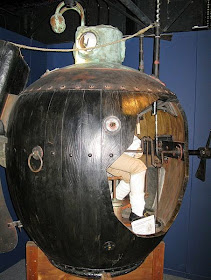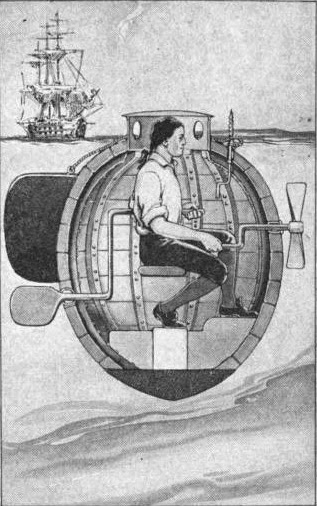by Catherine Curzon
If you don't like confined spaces, look away now for today we travel back more than two hundred years to 7th September 1776 and find ourselves not so much all at sea, as all under a river as Sergeant Ezra Lee makes history with the first submersible attack, safely ensconced in the American vessel, Turtle. His mission was to approach the British HMS Eagle, attach explosives to her hull and then make good his daring escape! Needless to say, all did not go quite according to plan.
The Turtle was built by David Bushnell in Old Saybrook, Connecticut, in 1775. Buoyed by government funding and convinced that the Turtle was the answer to vanquishing the British permanently, Bushnell handed over the completed submersible following extensive tests and waited for his invention to play its part in the destruction of the flagship vessel.
At eleven o'clock in the evening of 6th September, Lee took to the Hudson River in the Turtle, guided out by rowboats to start his journey until, finally, he began to pilot his craft towards the Eagle. In fact, the submersible barely moved at all until favourable currents caught it and propelled it towards the ship. Just as all seemed to be going to plan, Lee was faced with what would prove to be an insurmountable obstacle as, when he attempted to drill into the Eagle to attach the explosives, he had the misfortune to choose a spot directly atop the iron plates that protected the intricate rudder.
Not to be deterred, he continued to try to drill into the ship for some time until exhaustion forced him to stop. A somewhat cursory attempt to go directly under the hull and drill again proved futile and the thoroughly beaten Sergeant decided that the time had come to call off the operation. As he fled at a couple of miles an hour, Lee set off the explosives anyway to distract British lookouts and the Eagle lived to sail another day. Although Lee reported that the charge set off an enormous explosion and columns of water rose from the river, the British reported nothing untoward and appear to have been utterly unaware of the failed assault on their fleet.
The Turtle itself met a sticky end in October when the vessel that was carrying it was sunk at New Jersey. Submarine warfare would, of course, go on to be a major part of combat but for Lee, Bushnell and the Turtle, the underwater battle was over.
References
Compton-Hall, Richard. The Submarine Pioneers. Sutton Publishing, 1999.
Swanson, June. David Bushnell and His Turtle: The Story of America's First Submarine. Atheneum, 1991.
~~~~~~~~~~~~~
If you don't like confined spaces, look away now for today we travel back more than two hundred years to 7th September 1776 and find ourselves not so much all at sea, as all under a river as Sergeant Ezra Lee makes history with the first submersible attack, safely ensconced in the American vessel, Turtle. His mission was to approach the British HMS Eagle, attach explosives to her hull and then make good his daring escape! Needless to say, all did not go quite according to plan.
 |
| A model of the Turtle |
The Turtle was built by David Bushnell in Old Saybrook, Connecticut, in 1775. Buoyed by government funding and convinced that the Turtle was the answer to vanquishing the British permanently, Bushnell handed over the completed submersible following extensive tests and waited for his invention to play its part in the destruction of the flagship vessel.
At eleven o'clock in the evening of 6th September, Lee took to the Hudson River in the Turtle, guided out by rowboats to start his journey until, finally, he began to pilot his craft towards the Eagle. In fact, the submersible barely moved at all until favourable currents caught it and propelled it towards the ship. Just as all seemed to be going to plan, Lee was faced with what would prove to be an insurmountable obstacle as, when he attempted to drill into the Eagle to attach the explosives, he had the misfortune to choose a spot directly atop the iron plates that protected the intricate rudder.
 |
| A cutaway depiction of David Bushnell's Turtle from "The Story of the Submarine", by Farnham Bishop, 1916 |
Not to be deterred, he continued to try to drill into the ship for some time until exhaustion forced him to stop. A somewhat cursory attempt to go directly under the hull and drill again proved futile and the thoroughly beaten Sergeant decided that the time had come to call off the operation. As he fled at a couple of miles an hour, Lee set off the explosives anyway to distract British lookouts and the Eagle lived to sail another day. Although Lee reported that the charge set off an enormous explosion and columns of water rose from the river, the British reported nothing untoward and appear to have been utterly unaware of the failed assault on their fleet.
The Turtle itself met a sticky end in October when the vessel that was carrying it was sunk at New Jersey. Submarine warfare would, of course, go on to be a major part of combat but for Lee, Bushnell and the Turtle, the underwater battle was over.
References
Compton-Hall, Richard. The Submarine Pioneers. Sutton Publishing, 1999.
Swanson, June. David Bushnell and His Turtle: The Story of America's First Submarine. Atheneum, 1991.
Glorious Georgian ginbag, gossip and gadabout Catherine Curzon, aka Madame Gilflurt, is the author of A Covent Garden Gilflurt’s Guide to Life. When not setting quill to paper, she can usually be found gadding about the tea shops and gaming rooms of the capital or hosting intimate gatherings at her tottering abode. In addition to her blog and Facebook, Madame G is also quite the charmer on Twitter. Her first book, Life in the Georgian Court, is available now, and she is also working on An Evening with Jane Austen, starring Adrian Lukis and Caroline Langrishe.

I have always been intensely interested in submersibles, and so is my son, who has a segment of his anthology Jinn dealing with one. .I especially enjoyed learning about the Turtle.
ReplyDeleteIt's a fascinating episode in the history of naval conflict!
DeleteAs close neighbours of Old Saybrook at the Southeastern end of Connecticut, we have visited Essex numerous times and have seen the model of the Turtle. Of course, we build better submersibles today at the EB shipyards on the Thames, SSN21s, fast attack submarines. There are still many of our "big boomers" still in service as well.
ReplyDeleteI would love to see the model; how lucky you are!
DeleteAs close neighbours of Old Saybrook at the Southeastern end of Connecticut, we have visited Essex numerous times and have seen the model of the Turtle. Of course, we build better submersibles today at the EB shipyards on the Thames, SSN21s, fast attack submarines. There are still many of our "big boomers" still in service as well.
ReplyDelete